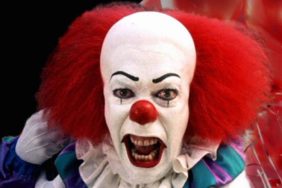Photo: Promotional still from “It”
Do clowns have more fun? You might think so given the fact that 197 million people watched the trailer for the upcoming It movie within 24 hours of its release last month, setting the global record for views. It far outshone the previous record of 139 million, held by the first Fate of the Furious trailer. If that weren’t enough, a mere 12 hours after that, it reached 246 million views.
Also: The “Killer Clown” Phenomenon Takes America by Storm
The long-awaited adaptation of Stephen King’s 1986 horror classic, It follows the exploits of seven children being preyed upon by “It,” the phenomenon of fear and terror that takes the form of Pennywise the Clown to attract—and terrify—small children. The film, which has been in development since 2009, will officially release September 8, 2017—and has audience in a state of anticipation that promises big box office results.
They say “Everyone loves a clown”—but they are wrong. Many people find them disconcerting and disturbing, with their grotesquely made-up faces painted in jarring colors that make the person underneath impossible to identify. Their faces become distorted masks of fake cheer or sadness. Their hair takes the texture of a glorious afro and adds colors from an acid-trip. When set against a chalk-white face, it is wholly out of place. Add to this the clothing, which evokes hoboes and vagabonds of an earlier age, campy costumes that combine flashing ensembles with signs of poverty, along with transgressive, anti-social behaviors, and you have crafted a nightmarish image of masculinity run amok.
For many people, the fear of clowns is more than a discomfort—it is a disorder known as “coulrophobia.” Although the term is not included in the American Psychiatric Association’s DSM-5, it is a very real sensation for those who have a morbid terror of people who disguise themselves in this manner.

Promotional still from “It”
Indeed, the fear of clowns is so prevalent is spawned a “killer clown” phenomenon that took America by storm last fall, as sightings of suspicious clowns in the woods were seen up and down the Eastern seaboard. The police reports and bad publicist made some professional clowns feel their lives were at risk—and indeed, they were not wrong. On October 4, Carlos Mendoza, 31 was found lying wounded on a highway in New Jersey, dressed in a clown costume. He had been shot in the head and died that same evening.
The loathing of clowns can be traced all the way back to Shakespeare, who crafted the character of the fool with Machiavellian intentions. The purpose of the fool, or jester, was to say what could not be said, but when combined with a darker purpose, they could wreak havoc and cause disaster. Invariably Shakespeare understood that trust in fools was greatly misplaced, and that we should keep an eye on them to make sure they aren’t making things worse.
The clown as jester found new form in The Joker, the villain in the Batman series. He was a sophisticated clown, in as much as he kept his look pared down, but the pale white face and eerie red gash of lips belied his sinister intentions.

Promotional still from “It”
It was only a matter of time before someone would seize the opportunity to bring art to life. John Wayne Gacy was just that man. Between 1972 and 1978, he sexually assaulted and murdered 33 teenage boy and young men in his home in Cook County, Illinois. The media dubbed Gacy the “Killer Clown,” after it came to light that he dressed as “Pogo the Clown” for fundraisers, parades, and children’s parties. Gacy was arrested in 1978, tried and convicted in 1980, and put to death by lethal injection in 1994. It is reported his final words were, “Kiss my ass.”
Soon thereafter a rash of “killer clown” sightings seized the nation. Like Bigfoot and the Lochness Monster, these mystical, mythical beasts were never found, but they obtained such stature in the public mind that they were believed real. Crytozoologist Loren Coleman dubbed this phenomenon “The Phantom Clown Theory,” based in the phenomenon of mass hysteria among children who have a “primal dread” of clowns.
No stranger to childhood terrors, Stephen King seized upon this when he wrote It, capturing the inherent fear and loathing that clowns breed. At the same time, people can’t seem to get enough—as the record views of the 2017 trailer indicate. Perhaps the old saw should be updated to accurately reflect the times: Everyone loves to hate a clown—and that’s where the treasure lies.
Miss Rosen is a journalist covering art, photography, culture, and books. Her byline has appeared in L’Uomo Vogue, Vogue Online, Whitewall, The Undefeated, Dazed Digital, Jocks and Nerds, and L’Oeil de la Photographie. Follow her on Twitter @Miss_Rosen.






